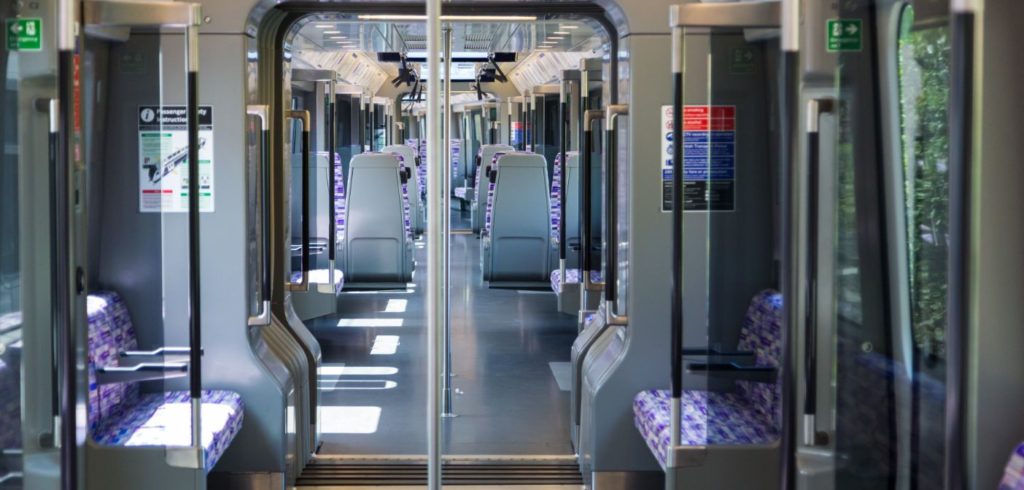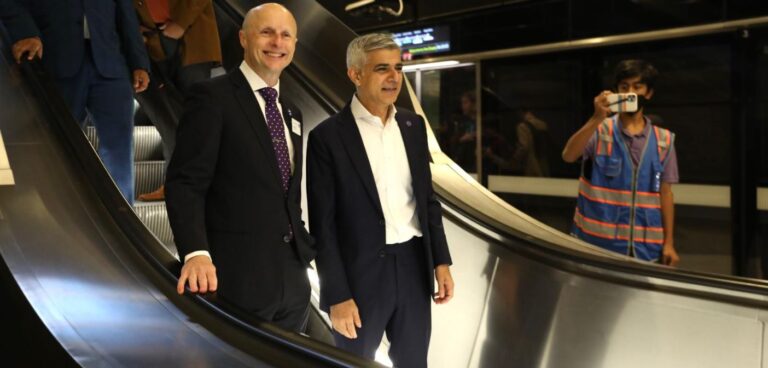Today’s opening of the Elizabeth line is a “game changer for all of the UK” and demonstrates “levelling up in action”, according to Transport for London (TfL) commissioner Andy Byford, responding to criticism of the £19bn project as another example of investment bias toward the South East, with areas of the North left with slower and older train services between key cities.
After 20 years of planning, construction and delays, the first trains started operating on the long-awaited railway from 6:30am this morning between Paddington and Abbey Wood, with a journey time of 29 minutes.
Byford (pictured above), who was onboard the first trains, alongside Mayor of London, Sadiq Khan, Elizabeth line director, Howard Smith, TfL COO, Andy Lord, and Crossrail CEO, Mark Wild, said businesses from around the UK had benefited from work connected to the Elizabeth line.
“Throughout its construction, the railway has had an extensive supply chain that has supported businesses of all sizes, and jobs and skills creation across the whole country. So I would argue that investment in transport in London is levelling up in action.
“For example, the Class 345 trains running on the Elizabeth line were built in Derby, roundels and signage for the line were supplied by a family-run business on the Isle of Wight, and a company based in Leeds strengthened and protected London’s Victorian sewer networks during construction,” said Byford.
In addition to job creation, Byford said the service itself would add an estimated £42bn to the UK economy, which would, in turn, “fuel the laudable schemes that are being proposed up north”.
When asked if the Elizabeth line fits into a more sustainable transport network for London, Byford said, “I think it fits right in with that objective because it offers very quick travel in clean, spacious trains and stations, which will help get people out of their cars in droves and onto the railways, which is exactly what we want.”

Despite being four-and-a-half years late and approximately £4bn over budget, a fleet of 70 trains across nine new stations in central London now provide Elizabeth line services every five minutes from 6:30am until 11:00pm Monday to Saturday and the 62-mile (100km) route now appears on the Tube map.
With 12 trains per hour, the new railway will provide new journey options and bring 1.5 million people within a 45-minute commute of central London’s major business, finance, leisure and tourism hubs.
It stretches from Reading to Heathrow in the west, through central London, to Abbey Wood in the southeast of the city and Shenfield in Essex, and is expected to serve some 200 million passengers – increasing the capital’s rail capacity by 10%.
However, only one of the line’s three branches has opened and services are not yet running uninterrupted along the entire line. Passengers must currently change at Paddington until autumn, while those going between central London and Shenfield have to change at Liverpool Street.
What’s more, Liverpool Street will be closed on Sundays to allow for more testing and software updates, and Bond Street station is not expected to open until the autumn.
By May 2023, TfL expects all three branches to be fully connected with 24 trains per hour at peak times. Signalling systems will allow capacity to expand to 30 trains per hour – one every two minutes – “without major modification”.
The full 62-mile route includes 25.5 miles (41km) of tunnels and track under London and 36.5 miles (59km) above ground. The trains can reach 60mph underground and 90mph above ground.
According to TfL, London has paid for most of the Elizabeth line, with nearly 70% of the total funding paid by London – made up of roughly 30% from London’s farepayers, around 40% from London businesses – combined with 30% from government.
Ticket prices are the same as they are on current TfL routes and passengers can pay contactless along the entire line.
The Elizabeth line: did you know?
- The tunnels took three years and eight tunnel boring machines to build
- More than three million tonnes of soil excavated from the tunnels were shipped to Wallasea Island in Essex to create new a RSPB wetland nature reserve
- During construction, 100 archeologists uncovered tens of thousands of items spanning 55 million years, including Tudor bowling balls, Roman medallions and a woolly mammoth’s jawbone from the last ice age
- The trains have seven or nine carriages with three sets of double doors per carriage
- Each one has 50 miles of cabling and five miles of welding
- Efficient engineering means they use 30% less energy than current trains with carriage insulation to reduce heat loss
- 10 new underground stations have been built with the remaining 31 benefiting from major improvements to facilitate the new trains





